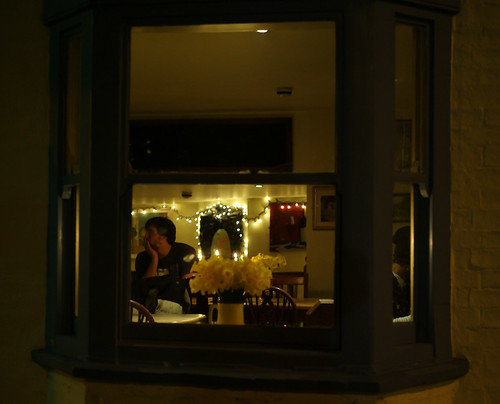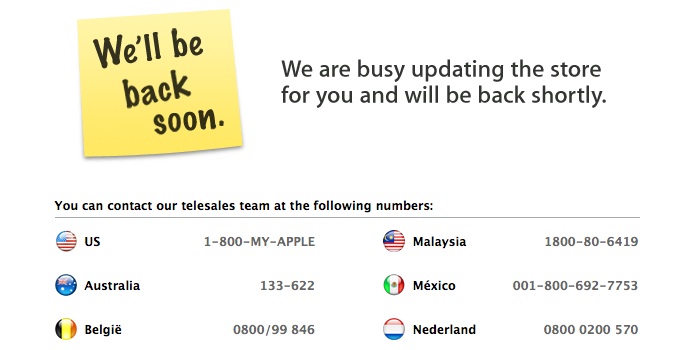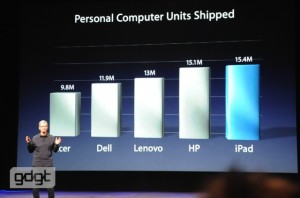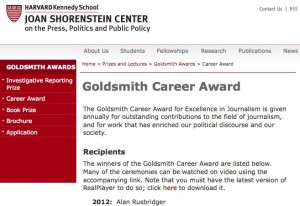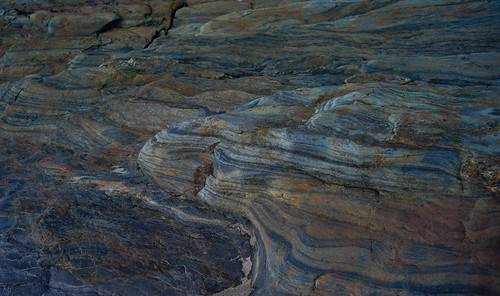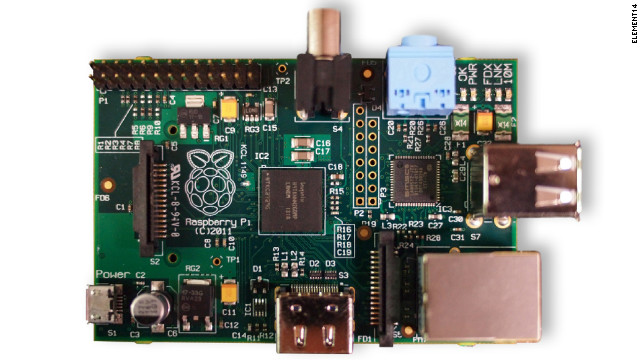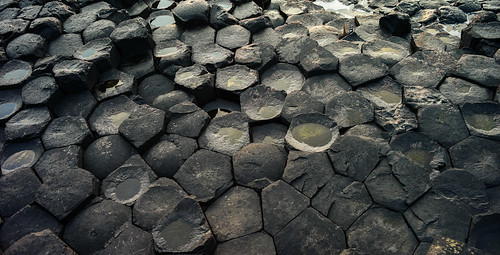Spotted on my way home from an enjoyable dinner with a colleague.
Swamped by iPad3?
Interesting: it’s now 21.38 on March 7, just over three and a half hours since Apple announced the iPad3 and their website is clearly being swamped — to the point where they have had to put up a static page.
(Image from GDGT’s excellent live blog of the presentation.)
In the presentation, CEO Tim Cook claimed that Apple had sold 15.4 million iPads in the last quarter. That’s more than the number of PCs sold by any of the big computer manufacturers.
Other interesting factoids from the presentation: iPad, iPhone, and iPod sales accounted for 76% of Apple’s revenue during that quarter, and the company sold more than 172 million of these devices in total last year. In comparison, all PC makers combined shipped about 350 million PCs last year.
Rusbridger wins Goldsmith career award from Harvard
Details here.
The problem with taking the tabloids
Amid the furore surrounding the Leveson Inquiry, one aspect of the affair is curiously absent: the role of the great British public in all of this. To illustrate this, consider the paradox that at a time when an increasing number of Sun journalists have been arrested on suspicion of making or facilitating corrupt payments to public officials, Rupert Murdoch launches the Sunday Sun to replace the late lamented News of the World — and it sells 3m copies on its launch day. So three million of our fellow-citizens went out and, of their own volition, paid good money to buy the thing.
And that, it seems to me, lies at the root of the problem. The underlying cause of the malfeasance at the Sun and other tabloid papers is that the tabloid market is an intensely competitive one. That’s why journalism in Britain can never be a ’profession’ — with all that implies in terms of standards, ethics and professional sanctions: it’s a trade grafted onto businesses operating in a fiercely competitive market. So journalists on tabloid newspapers are under intense pressure to come with ’stories’ that will give their paper a competitive edge.
But sleazy journalism wouldn’t give them such an edge if readers exercised some kind of moral or ethical judgement when choosing newspapers to buy. So the responsibility ultimately rests with consumers of the British tabloid product. If they genuinely abhorred the kinds of journalistic practices now being unearthed by Leveson, then the incentives to break or bend the law would be dramatically reduced. Bad behaviour would be punished. But what happens instead is that bad behaviour is rewarded — by increased circulation. (***See footnote)
So the great mystery is why consumers of journalistic products seem to be ethically neutered. I had a disturbing insight into this many years ago when visiting some friends of a friend. The couple in question were lovely, decent, unpretentious people in their mid-sixties from a working-class background. I noticed that they were readers of the Daily Express and asked if they were regular subscribers. They were. So, I asked, did it bother them that the paper they read every day was owned by a pornographer?
What was astonishing (to me) is that they were completely floored by the question — not in the sense that they didn’t have an answer, but in the sense that the question seemed, literally, meaningless to them. The idea that there might be an ethical dimension to their newspaper purchasing habit had clearly never crossed their minds. So there was an awkward silence and the conversation moved on. But as I saw the sales figures for the new Sunday Sun, memories of that conversation came flooding back. And as long as media ’consumption’ takes place in that ethical vacuum, then the problems being unearthed by Leveson will continue to plague us.
…………..
*Footnote: As far as I can remember, there has only been one occasion in recent history where bad behaviour was punished by readers — and that was when Liverpool readers boycotted the Sun after its disgraceful allegations about the behaviour of Liverpool football fans during the Hillsborough disaster.
My colleague Andrew Cupples points out that the Sun’s readership in Liverpool has never recovered from the paper’s coverage of the disaster. He pointed me at a Guardian story on the 20th anniversary of Hillsborough, which reads, in part:
The newspaper, which has a circulation of more than 3m nationally, sold just 8,000 copies in the area on the day of the memorial service at Anfield, which was attended by more than 30,000 people.
Inside the newspaper, still known as “The Scum” in Liverpool, “lifelong fan” David Wooding, the Whitehall editor, delivered a poignant tribute to the men, women and children who lost their lives. But for those who gathered at Anfield this week, it was far too little and far too late.
At the Albert pub, squeezed next to the ground, football scarves and Liverpool memorabilia cover the walls and ceiling. The entrance of the pub has a poster mocking the front page of the Sun’s notorious splash, which appeared a few days after the tragedy. The tabloid’s masthead appears to be dripping in blood. “The truth,” it reads. “96 dead. Hillsborough 15th April 1989. Don’t buy the Sun.”
Tommy Doran, who works at the Albert, remembers one regular reading the Sun in a corner of the pub. “I went over to him and said: ‘What’s that?’ and he went: ‘The Sun.’ I just ripped it up into pieces in front of him.” Like many others on Merseyside, Doran will never forgive the decision of then editor Kelvin MacKenzie to lead on 19 April 1989 with a story headlined “The Truth” that was anything but. In it, quoting unnamed police sources and a Tory MP, it claimed drunken Liverpool fans urinated on and picked the pockets of the dead, hampered rescue efforts and attacked policemen.
And the Wikipedia entry about the Hillsborough catastrophe claims that:
Many people in the Liverpool area continue to reject buying The Sun as a matter of principle, and the paper’s sales figures within Merseyside remain very poor. It is the only major newspaper not to have articles published on Liverpool’s official website. As of 2004, the average daily circulation of The Sun in Liverpool was just 12,000 copies a day. Some Liverpudlians refer to the paper as simply: The Scum.
This is interesting, but I suspect it’s the exception that proves the rule.
What all golf courses should be like
I grew up playing on links (i.e. seaside courses laid out in sand-dunes) and I still think that only links courses are ‘real’ golf courses. Today we came on a lovely links course which is one of Ireland’s best-kept secrets — the Narin and Portnoo club at Narin. Lovely, unpretentious and utterly charming.
What you learn if your formative years are spent on links courses is never to hit the ball high. Because most of the time you’re battling against serious wind, the name of the game is to keep the ball out of it.
Er, I can bore for Ireland on this topic. (Hmmm… I see that I already have — here.)
Larger image here.
Geology as Art
Rock formations in Donegal. Amazing colours. The large size is more revealing.
Remix culture: why some videos go viral
Interesting, but ultimately not very illuminating, attempt at an answer by YouTube’s “Trends Manager”. What? You didn’t know that trends could be managed? Neither did I.
Thanks to Brian for spotting it.
Raspberry Pi today. Jam tomorrow
This morning’s Observer column.
The Raspberry Pi project – a philanthropic effort to create the contemporary equivalent of the BBC Micro of yesteryear – has graduated from idealistic vapourware dreamed up in Cambridge to a finished, deliverable product manufactured in China. (In a nice touch, the Pi device comes in two flavours, Model A and Model B, just like the BBC machine, which was also designed in Cambridge.) Over the next few months, we’ll see container-loads of the little computer boards delivered to these shores. The time has come, therefore, to start thinking about how this astonishing breakthrough can be exploited in our schools.
Here are a few suggestions.
First, we need to jettison some baggage from the past. In particular, we have to accept that ICT has become a toxic brand in the context of British secondary schools…
Antrim coast at sunset
Natural geometry
I’ve always wanted to see the Giant’s Causeway in Co Antrim, and yesterday finally achieved that ambition. It’s a remarkable geological phenomenon, 40,000 interlocked basalt columns which were the product of an ancient volcanic eruption. We got there at the end of the day, as the sun was setting, and it was quite magical — and almost deserted, despite being one of UNESCO’s World Heritage Sites. I had expected only hexagons, but in this stretch the columns seemed to be mainly pentagonal in cross-section. And the light was wonderful. We ran into another photographer who was similarly transported by it.
Larger image here.
